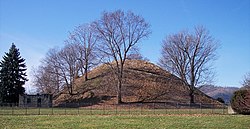Grave Creek Mound
|
Grave Creek Mound
|
|

Grave Creek Mound in 2006
|
|
| Location | Tomlinson and 9th Streets, Moundsville, West Virginia |
|---|---|
| Coordinates | 39°55′00.86″N 80°44′40.49″W / 39.9169056°N 80.7445806°W |
| NRHP reference # | 66000751 |
| Significant dates | |
| Added to NRHP | October 15, 1966 |
| Designated NHL | July 19, 1964 |
The Grave Creek Mound in the Ohio River Valley in West Virginia is one of the largest conical-type burial mounds in the United States, standing 62 feet (19 m) high and 240 feet (73 m) in diameter. The builders of the site, members of the Adena culture, moved more than 60,000 tons of dirt to create it about 250–150 BC.
Present-day Moundsville has developed around it near the banks of the Ohio River. The first recorded excavation of the mound took place in 1838, and was conducted by local amateurs. The largest surviving mound among those built by the Adena, this was designated a National Historic Landmark in the mid-20th century.
In 1978 the state opened the Delf Norona Museum at the site. It displays numerous artifacts and interprets the ancient Adena Culture. In 2010, under an agreement with the state, the US Army Corps of Engineers gave nearly 450,000 artifacts to the museum for archival. These were recovered in archeological excavations at the site of the Marmet Lock, and represent 10,000 years of indigenous habitation in the area.
Grave Creek Mound is the largest conical type of any of the mound builder structures. Construction of the earthwork mound took place in successive stages from about 250–150 B.C., as indicated by the multiple burials at different levels within the structures. In 1838, road engineers measured its height at 69 feet (21 m) and its base as 295 feet (90 m).
Originally a moat of about 40 feet (12 m) in width and five feet (1.5 m) in depth, with one causeway across it, encircled the mound for defensive purposes. Inside the mound, archaeological researchers have discovered Adena Hopewell remains and ornaments. In addition, they discovered a small sandstone tablet, the Grave Creek Stone, which modern scholars believe to be a hoax.
Grave Creek mound was created during the Woodland time period (late Adena Period around 1000 BC to about 1 AD). The people who lived in West Virginia during this time are among those groups classified as Mound Builders. This particular tumulus or burial mound was built in successive stages over a period of a hundred years.
...
Wikipedia
